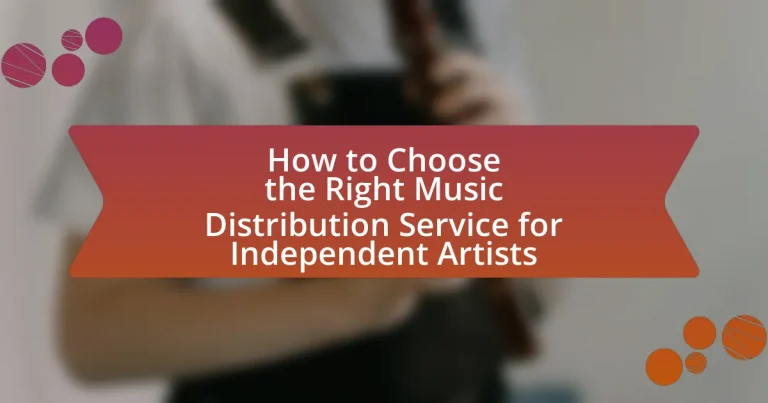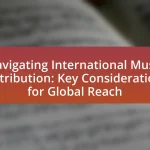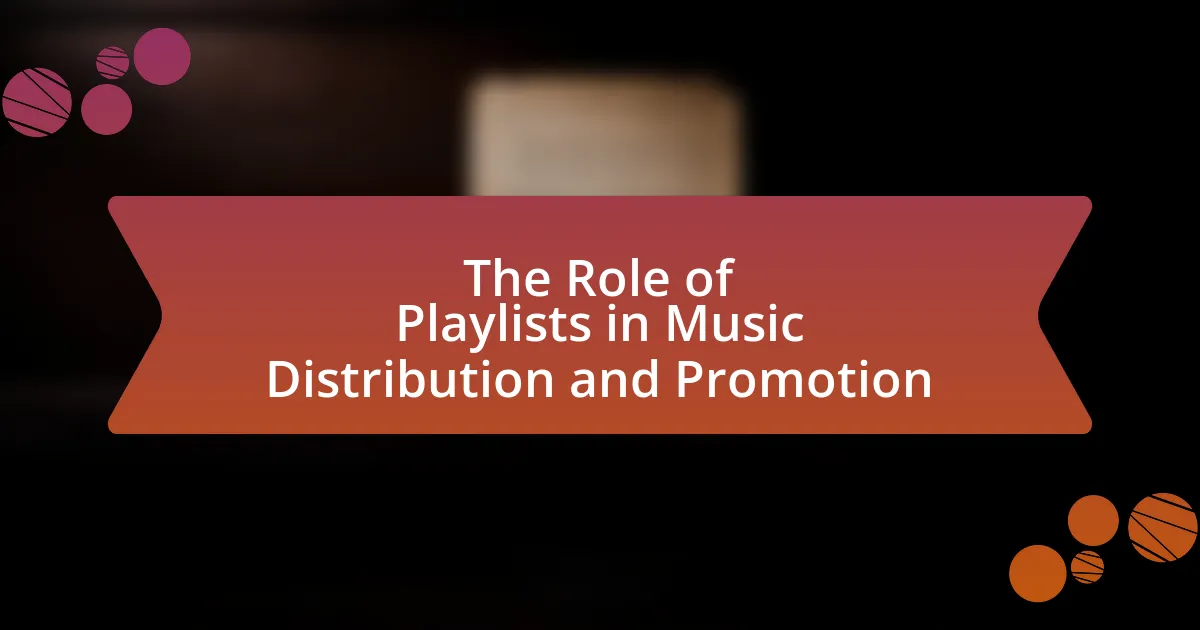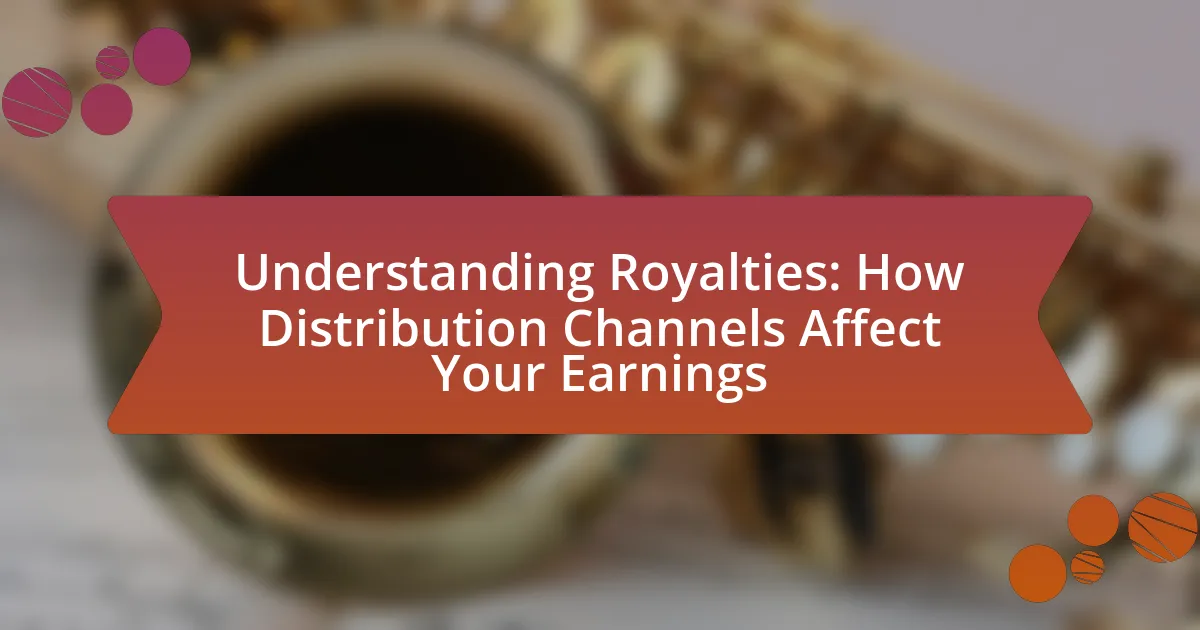A music distribution service for independent artists is a platform that enables musicians to distribute their music across various digital streaming services and online stores, such as Spotify and Apple Music. This article outlines the functions of these services, including digital distribution, royalty collection, and analytics, which empower artists to manage their careers effectively. It also discusses the importance of music distribution for reaching wider audiences and monetizing work, as well as key factors to consider when selecting a distribution service, such as fees, distribution reach, and additional features. Furthermore, the article highlights common pitfalls to avoid and best practices for maximizing the benefits of music distribution services.
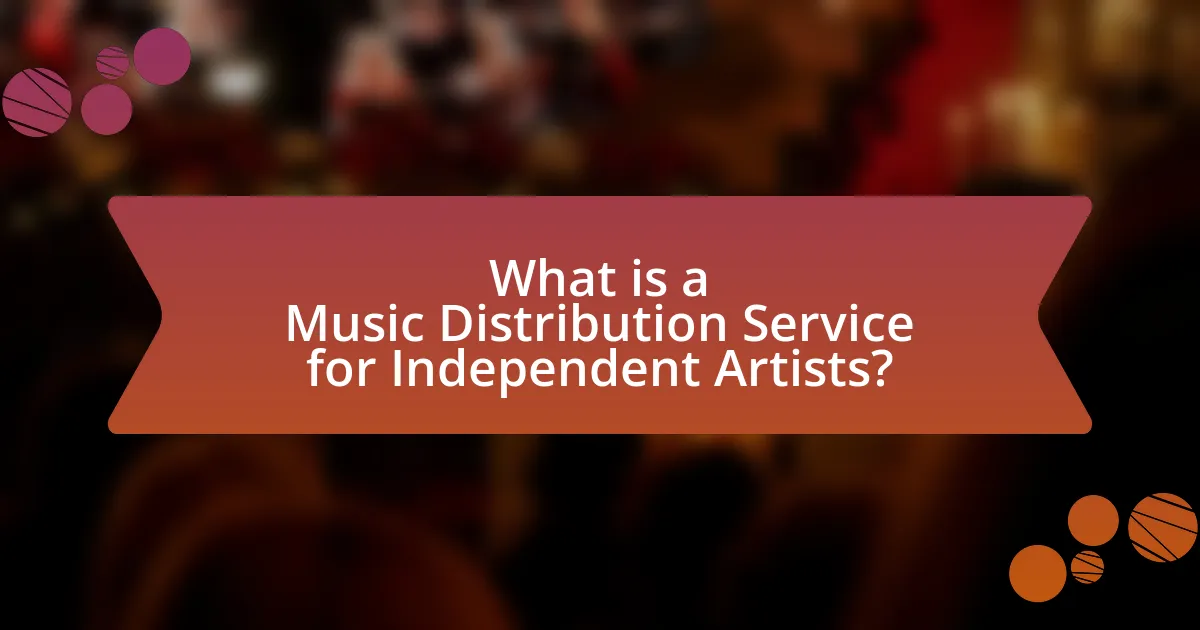
What is a Music Distribution Service for Independent Artists?
A music distribution service for independent artists is a platform that enables musicians to distribute their music to various digital streaming services and online stores. These services facilitate the release of music on platforms such as Spotify, Apple Music, and Amazon Music, allowing independent artists to reach a wider audience without the need for a traditional record label. According to a report by the International Federation of the Phonographic Industry (IFPI), digital music revenues have been growing, highlighting the importance of distribution services in helping independent artists monetize their work effectively.
How do music distribution services function?
Music distribution services function by facilitating the delivery of music from artists to various digital platforms, such as Spotify, Apple Music, and Amazon Music. These services act as intermediaries, allowing independent artists to upload their music, which is then distributed to multiple streaming services and online stores.
Typically, artists create an account with a distribution service, upload their tracks, and provide necessary metadata, such as song titles and cover art. The distribution service then encodes the music files and ensures they meet the technical requirements of each platform. Once the music is distributed, the service collects royalties on behalf of the artist, providing them with a percentage of the earnings generated from streams and downloads.
For example, services like DistroKid and TuneCore have established partnerships with major streaming platforms, ensuring that artists’ music reaches a wide audience while also simplifying the royalty collection process. This model has become essential for independent artists seeking to monetize their work in the digital age.
What are the key features of music distribution services?
Music distribution services primarily offer features such as digital distribution, royalty collection, and analytics. Digital distribution enables artists to release their music across various streaming platforms and online stores, ensuring wide accessibility. Royalty collection involves managing and distributing earnings from streams and sales, which is crucial for artists to receive fair compensation. Analytics provide insights into listener demographics, streaming statistics, and sales performance, allowing artists to make informed decisions about their marketing and future releases. These features collectively empower independent artists to effectively manage their music careers in a competitive landscape.
How do these features benefit independent artists?
The features of music distribution services benefit independent artists by providing them with greater control over their music, increased revenue opportunities, and access to a wider audience. These services enable artists to retain ownership of their work, allowing them to set their own pricing and distribution strategies. For instance, platforms like DistroKid and TuneCore allow artists to distribute their music across multiple streaming services while keeping 100% of their royalties. Additionally, these services often include analytics tools that help artists track their performance and audience engagement, which is crucial for making informed marketing decisions. This combination of control, revenue retention, and data access empowers independent artists to build sustainable careers in the music industry.
Why is music distribution important for independent artists?
Music distribution is crucial for independent artists because it enables them to reach a wider audience and monetize their work effectively. By utilizing distribution services, independent artists can place their music on major streaming platforms like Spotify, Apple Music, and Amazon Music, which collectively account for millions of listeners globally. This access not only increases visibility but also allows artists to earn revenue through streams and sales, which is essential for sustaining their careers. Furthermore, effective distribution can lead to opportunities for marketing, playlist placements, and collaborations, enhancing an artist’s overall growth and success in the competitive music industry.
What role does distribution play in an artist’s success?
Distribution plays a critical role in an artist’s success by ensuring their music reaches a wide audience across various platforms. Effective distribution allows artists to make their work available on streaming services, digital stores, and social media, which increases visibility and potential revenue. For instance, according to a report by the International Federation of the Phonographic Industry, digital music revenues grew by 19.9% in 2020, highlighting the importance of having music accessible through proper distribution channels. This accessibility not only enhances an artist’s chances of gaining new fans but also facilitates opportunities for collaborations, licensing, and live performances, all of which contribute to overall success in the music industry.
How can effective distribution impact an artist’s reach?
Effective distribution significantly enhances an artist’s reach by ensuring their music is accessible across multiple platforms and audiences. When an artist utilizes a robust distribution service, their work can be streamed or purchased on major platforms like Spotify, Apple Music, and Amazon Music, which collectively account for millions of users globally. This broad availability increases the likelihood of discovery by new listeners, thereby expanding the artist’s fan base. Furthermore, effective distribution often includes promotional tools and analytics that help artists understand their audience better, allowing for targeted marketing strategies that can further amplify their reach.
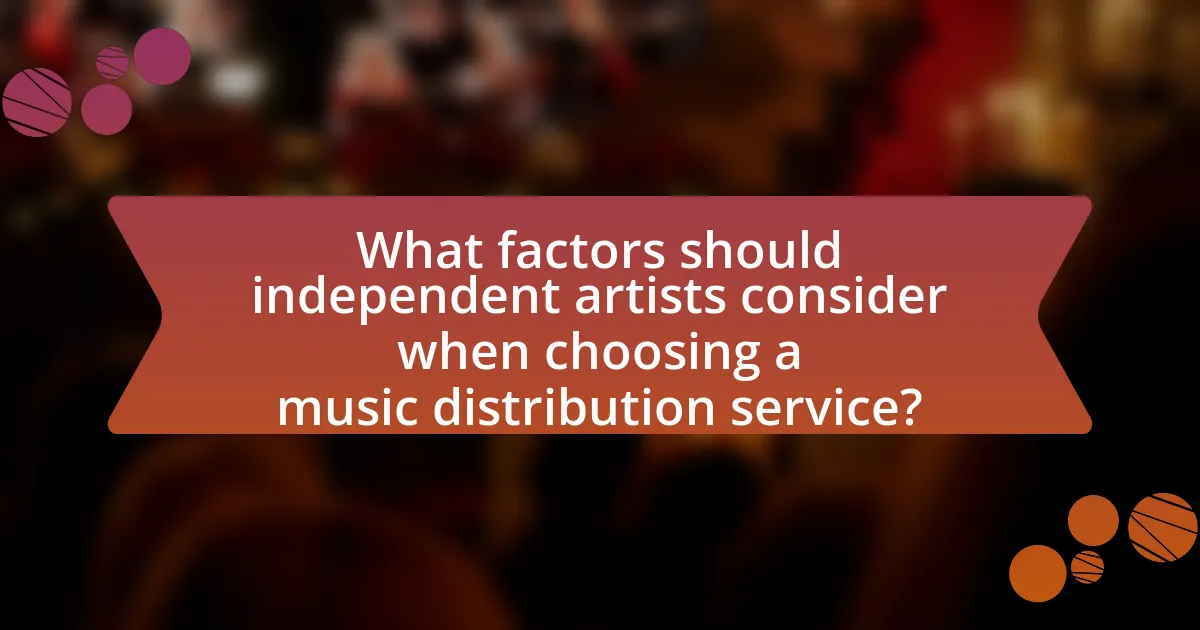
What factors should independent artists consider when choosing a music distribution service?
Independent artists should consider several key factors when choosing a music distribution service, including distribution reach, fees, and additional services offered. Distribution reach is crucial as it determines how many platforms, such as Spotify, Apple Music, and Amazon Music, the artist’s music will be available on, impacting potential audience size. Fees can vary significantly; artists should evaluate whether the service charges a flat fee, takes a percentage of royalties, or has hidden costs, as these can affect overall earnings. Additionally, services that offer marketing tools, analytics, and support can enhance an artist’s ability to promote their music effectively. For instance, according to a 2021 report by MIDiA Research, artists using distribution services with integrated marketing tools saw a 30% increase in engagement compared to those without.
How do pricing models vary among music distribution services?
Pricing models among music distribution services vary primarily in structure, fees, and revenue sharing. Some services, like DistroKid, offer an annual subscription fee that allows unlimited uploads, while others, such as TuneCore, charge per release. Additionally, platforms like CD Baby take a percentage of sales, typically around 9% to 15%, instead of upfront fees. This diversity in pricing models caters to different artist needs, with some preferring flat fees for predictability and others opting for pay-per-release models to minimize upfront costs. The choice of model can significantly impact an artist’s earnings and distribution strategy, making it essential for independent artists to evaluate their options based on their release frequency and revenue expectations.
What are the differences between one-time fees and subscription models?
One-time fees require a single payment for a product or service, while subscription models involve recurring payments over a specified period for continued access. One-time fees provide immediate ownership, such as purchasing a software license, whereas subscription models often offer ongoing updates and support, as seen in services like Spotify or Adobe Creative Cloud. The choice between these models can significantly impact cash flow and budgeting for independent artists, as one-time fees may be more manageable upfront, while subscriptions can lead to long-term costs that accumulate over time.
How can artists assess the value of the pricing options?
Artists can assess the value of pricing options by comparing the features and services offered by different music distribution platforms against their costs. This evaluation involves analyzing factors such as the percentage of royalties retained, additional services like marketing support, and the reach of distribution channels. For instance, a platform that charges a higher fee but offers extensive promotional tools and a wider audience may provide better long-term value than a cheaper option with limited services. Additionally, artists can look at user reviews and case studies to gauge the effectiveness of each service in generating revenue and exposure, thus validating their pricing assessments.
What distribution platforms are available for independent artists?
Independent artists can utilize several distribution platforms, including DistroKid, TuneCore, CD Baby, and Amuse. DistroKid allows artists to upload unlimited music for a yearly fee and distributes it to major streaming services like Spotify and Apple Music. TuneCore charges per release but offers a comprehensive service that includes publishing administration. CD Baby provides both digital and physical distribution options and takes a percentage of sales. Amuse offers a free distribution service with optional premium features. These platforms are widely recognized in the industry for their reliability and extensive reach, making them suitable choices for independent artists seeking to distribute their music effectively.
What are the most popular music distribution services currently?
The most popular music distribution services currently include DistroKid, TuneCore, CD Baby, and Amuse. DistroKid is known for its fast distribution and affordable pricing, allowing artists to upload unlimited tracks for a yearly fee. TuneCore offers a comprehensive service with a pay-per-release model, providing detailed sales reports and global distribution. CD Baby is recognized for its wide range of services, including physical distribution and sync licensing, catering to various artist needs. Amuse stands out with its free distribution model, appealing to independent artists looking to enter the market without upfront costs. These services are widely used due to their reliability, user-friendly interfaces, and extensive reach across streaming platforms.
How do these platforms differ in terms of services offered?
Music distribution platforms differ significantly in the services they offer. For instance, some platforms like DistroKid focus on rapid distribution and unlimited uploads for a flat annual fee, while others like CD Baby provide additional services such as physical distribution, sync licensing, and marketing tools. Additionally, platforms like TuneCore allow artists to retain 100% of their royalties but charge per release, contrasting with services like Amuse, which offers free distribution but takes a percentage of earnings. These differences in pricing models, additional services, and royalty structures are crucial for independent artists to consider when selecting a distribution service that aligns with their needs.
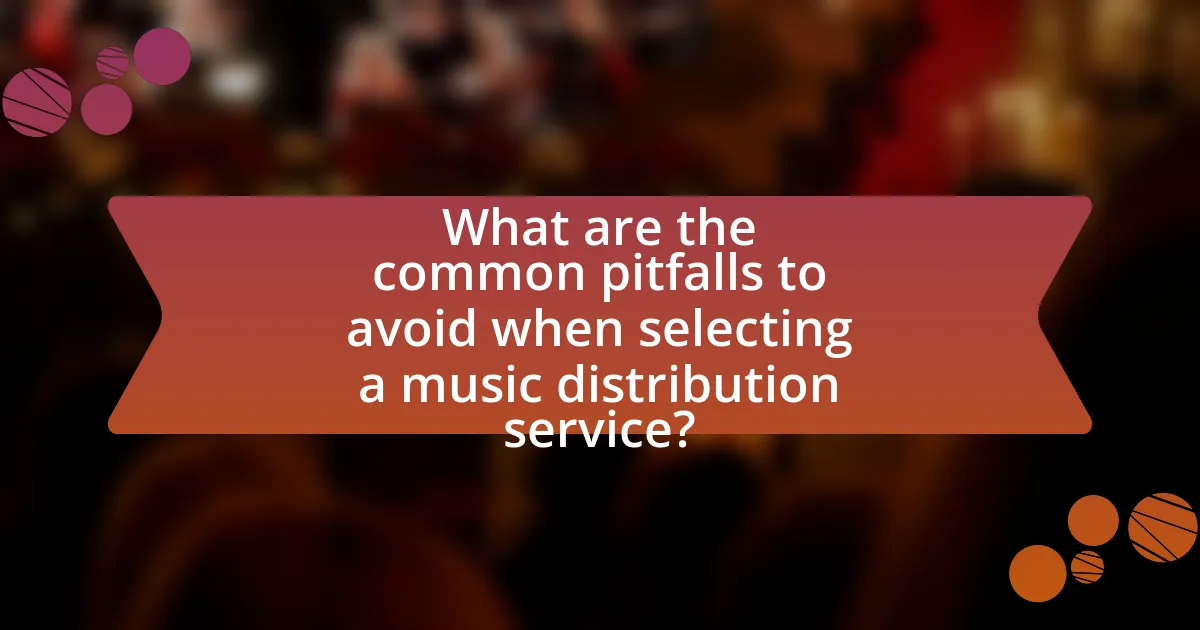
What are the common pitfalls to avoid when selecting a music distribution service?
When selecting a music distribution service, common pitfalls to avoid include overlooking the service’s fees, failing to understand the distribution terms, and neglecting to research the service’s reputation. Many artists mistakenly choose services based solely on low upfront costs, which can lead to hidden fees that diminish earnings. Additionally, not comprehending the terms of distribution, such as rights retention and revenue splits, can result in unfavorable agreements. Researching the service’s reputation through artist reviews and industry feedback is crucial, as some services may have a history of poor customer support or unreliable distribution.
What should artists watch out for in contracts and agreements?
Artists should watch out for clauses that limit their rights, such as exclusivity agreements, which can restrict their ability to distribute their music through other platforms. Additionally, they should be cautious of terms that dictate revenue splits, as unfavorable percentages can significantly impact their earnings. It’s also essential to scrutinize any language regarding ownership of intellectual property, ensuring that they retain rights to their work. Contracts should clearly outline the duration of the agreement and any renewal terms, as lengthy commitments can hinder future opportunities. Lastly, artists must be aware of any hidden fees or costs associated with distribution services, as these can erode profits.
How can hidden fees affect an artist’s earnings?
Hidden fees can significantly reduce an artist’s earnings by unexpectedly deducting amounts from their revenue. For instance, if a music distribution service charges hidden fees such as processing fees, annual fees, or percentage cuts from sales, the artist may receive far less than anticipated from their music sales. According to a 2021 report by the Music Industry Research Association, artists can lose up to 30% of their earnings due to undisclosed fees in distribution contracts. This financial impact can hinder an artist’s ability to reinvest in their music career, affecting their overall success and sustainability in the industry.
What terms should artists be cautious about in distribution agreements?
Artists should be cautious about terms related to royalties, exclusivity, and rights retention in distribution agreements. Specifically, they need to understand how royalties are calculated and distributed, as some agreements may offer unfavorable splits or hidden fees that reduce earnings. Additionally, exclusivity clauses can limit an artist’s ability to distribute their music through other platforms, potentially hindering their reach and revenue. Lastly, retaining rights to their music is crucial; agreements that require artists to relinquish ownership can have long-term negative implications on their creative control and future earnings. These considerations are vital for ensuring fair compensation and maintaining artistic freedom.
How can artists ensure they are making an informed choice?
Artists can ensure they are making an informed choice by thoroughly researching and comparing different music distribution services. This involves evaluating factors such as fees, distribution reach, royalty rates, and additional services offered, such as marketing support or analytics tools. For instance, a study by the Music Industry Research Association found that artists who compared at least three distribution options were 40% more likely to choose a service that aligned with their financial and promotional goals. By analyzing user reviews and seeking recommendations from fellow artists, they can gain insights into the reliability and effectiveness of each service.
What resources are available for comparing music distribution services?
Resources available for comparing music distribution services include websites like Digital Music News, which provides industry insights and comparisons, and platforms such as SoundOnSound that offer detailed reviews and user experiences. Additionally, comparison tools like Capterra and G2 allow users to evaluate features, pricing, and user ratings of various distribution services. These resources are validated by user-generated content and expert reviews, ensuring that artists can make informed decisions based on comprehensive data.
How can artist testimonials and reviews guide the decision-making process?
Artist testimonials and reviews significantly influence the decision-making process by providing firsthand accounts of experiences with music distribution services. These testimonials offer insights into the reliability, effectiveness, and overall satisfaction of artists who have utilized specific services. For instance, a study by the Nielsen Company found that 92% of consumers trust recommendations from individuals over brands, highlighting the importance of peer feedback in shaping choices. Additionally, reviews often detail specific features, customer support quality, and the ease of use of distribution platforms, enabling potential users to make informed comparisons. This collective feedback serves as a valuable resource for independent artists seeking to select the most suitable music distribution service for their needs.
What are the best practices for maximizing the benefits of a music distribution service?
To maximize the benefits of a music distribution service, independent artists should focus on selecting a service that offers comprehensive distribution channels, including major streaming platforms and digital stores. This ensures that their music reaches a wider audience, increasing potential revenue and exposure. Additionally, artists should actively engage in marketing their releases through social media, email newsletters, and collaborations, as these strategies can significantly enhance visibility and listener engagement. Utilizing analytics provided by the distribution service allows artists to track performance and adjust their strategies accordingly, optimizing future releases. Furthermore, understanding the terms and fees associated with the distribution service is crucial, as it helps artists retain more earnings and make informed decisions about their music career.
How can artists effectively promote their music post-distribution?
Artists can effectively promote their music post-distribution by leveraging social media platforms, engaging with fans through live performances, and utilizing targeted advertising. Social media platforms like Instagram, TikTok, and Facebook allow artists to share content, connect with their audience, and create buzz around their releases. Engaging with fans through live performances, whether virtual or in-person, fosters a deeper connection and encourages word-of-mouth promotion. Additionally, targeted advertising on platforms such as Spotify and YouTube can reach specific demographics, increasing visibility and driving streams. According to a 2021 report by the International Federation of the Phonographic Industry, digital music consumption has grown significantly, highlighting the importance of effective online promotion strategies for artists.
What strategies can enhance an artist’s visibility on streaming platforms?
To enhance an artist’s visibility on streaming platforms, utilizing social media marketing is essential. Artists should actively engage with their audience on platforms like Instagram, TikTok, and Twitter, sharing behind-the-scenes content, music snippets, and personal stories to build a loyal fanbase. Additionally, collaborating with other artists can expand reach; for instance, featuring on each other’s tracks or sharing playlists can introduce artists to new listeners.
Moreover, optimizing profiles on streaming services by using high-quality images, compelling bios, and relevant tags can improve discoverability. Regularly releasing new music and engaging with playlists, especially user-generated ones, can also significantly boost visibility. According to a study by MIDiA Research, artists who actively promote their music on social media see a 30% increase in streaming numbers compared to those who do not.
